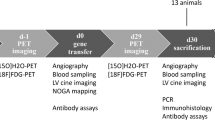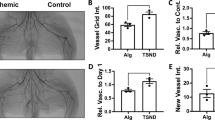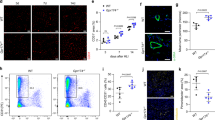Abstract
Hepatocyte growth factor (HGF) exclusively stimulates the growth of endothelial cells without replication of vascular smooth muscle cells, and acts as a survival factor against endothelial cell death. Recently, a novel therapeutic strategy for ischemic diseases using angiogenic growth factors to expedite and/or augment collateral artery development has been proposed. We have previously reported that intra-arterial administration of recombinant HGF induced angiogenesis in a rabbit hindlimb ischemia model. In this study, we examined the feasibility of gene therapy using HGF to treat peripheral arterial disease rather than recombinant therapy, due to its disadvantages. Initially, we examined the transfection of ‘naked’ human HGF plasmid into a rat hindlimb ischemia model. Intramuscular injection of human HGF plasmid resulted in a significant increase in blood flow as assessed by laser Doppler imaging, accompanied by the detection of human HGF protein. A significant increase in capillary density was found in rats transfected with human HGF as compared with control vector, in a dose-dependent manner (P < 0.01). Importantly, at 5 weeks after transfection, the degree of angiogenesis induced by transfection of HGF plasmid was significantly greater than that caused by a single injection of recombinant HGF. As an approach to human gene therapy, we also employed a rabbit hindlimb ischemia model as a preclinical study. Naked HGF plasmid was intramuscularly injected in the ischemic hindlimb of rabbits, to evaluate its angiogenic activity. Intramuscular injection of HGF plasmid once on day 10 after surgery produced significant augmentation of collateral vessel development on day 30 in the ischemia model, as assessed by angiography (P < 0.01). Serial angiograms revealed progressive linear extension of collateral arteries from the origin stem artery to the distal point of the reconstituted parent vessel in HGF-transfected animals. In addition, a significant increase in blood flow was assessed by a Doppler flow wire and the ratio in blood pressure of the ischemic limb to the normal limb was observed in rabbits transfected with HGF plasmid as compared with rabbits transfected with control vector (P < 0.01). Overall, intramuscular injection of naked human HGF plasmid induced therapeutic angiogenesis in rat and rabbit ischemic hindlimb models, as potential therapy for peripheral arterial disease.
This is a preview of subscription content, access via your institution
Access options
Subscribe to this journal
Receive 12 print issues and online access
$259.00 per year
only $21.58 per issue
Buy this article
- Purchase on Springer Link
- Instant access to full article PDF
Prices may be subject to local taxes which are calculated during checkout







Similar content being viewed by others
References
Second European Consensus Document on Chronic Critical Leg Ischemia Circulation 1991 84: (4 Suppl.) IV1–26
Dormandy J et al. Fate of the patient with chronic leg ischaemia. A review article J Cardiovasc Surg Torino 1989 30: 50–57
Rutherford RB et al. Suggested standards for reports dealing with lower extremity ischemia. Ad Hoc Committee on Reporting Standards. Society for Vascular Surgery/North American Chapter, International Society for Cardiovascular Surgery J Vasc Surg 1986 4: 80–94
Isner JM et al. Arterial gene transfer for therapeutic angiogenesis in patients with peripheral artery disease Hum Gene Ther 1996 7: 959–988
Baumgartner I et al. Constitutive expression of phVEGF165 after intramuscular gene transfer promotes collateral vessel development in patients with critical limb ischemia Circulation 1998 97: 1114–1123
Losordo DW et al. Gene therapy for myocardial angiogenesis: initial clinical results with direct myocardial injection of phVEGF165 as sole therapy for myocardial ischemia Circulation 1998 98: 2800–2804
Lewin B . Oncogenic conversion by regulatory changes in transcription factors Cell 1991 64: 303–312
Risau W, Flamme I . Vasculogenesis Ann Rev Cell Dev Biol 1995 11: 73–91
Nakamura T et al. Molecular cloning and expression of human hepatocyte growth factor Nature 1989 342: 440–443
Nakamura Y et al. A vascular modulator, hepatocyte growth factor, is associated with systolic pressure Hypertension 1996 28: 409–413
Nakamura Y et al. Hepatocyte growth factor is a novel member of the endothelium-specific growth factors: additive stimulatory effect of hepatocyte growth factor with basic fibroblast growth factor but not with vascular endothelial growth factor J Hypertens 1996 14: 1067–1072
Hayashi S et al. Autocrine–paracrine effects of overexpression of hepatocyte growth factor gene on growth of endothelial cells Biochem Biophys Res Commun 1996 220: 539–545
Morishita R et al. Therapeutic angiogenesis induced by human recombinant hepatocyte growth factor in rabbit hind limb ischemia model as ‘cytokine supplement therapy’ Hypertension 1999 33: 1379–1384
Belle EV et al. Potentiated angiogenic effect of scatter factor/hepatocyte growth factor via induction of vascular endothelial growth factor: the case for paracrine amplification of angiogenesis Circulation 1998 97: 381–390
Ono K et al. Enhanced expression of hepatocyte growth factor/c-Met by myocardial ischemia and reperfusion in a rat model Circulation 1997 95: 2552–2558
Morishita R et al. Potential role of endothelium-specific growth factor, hepatocyte growth factor, on endothelial damage in diabetes mellitus Diabetes 1997 46: 138–142
Yo Y et al. Potential role of hepatocyte growth factor in the maintenance of renal structure: anti-apoptotic action of HGF on epithelial cells Kidney Int 1998 54: 1128–1138
Nakano N et al. Negative regulation of local hepatocyte growth factor (HGF) expression by angiotensin II and transforming growth factor-β in blood vessels: potential role of HGF in cardiovascular disease Hypertension 1998 32: 444–451
Hayashi S et al. Potential role of hepatocyte growth factor, a novel angiogenic growth factor, in peripheral arterial disease: down-regulation of HGF in response to hypoxia in vascular cells Circulation 1999 100: II301–II308
Aoki M et al. Efficient in vivo gene transfer into heart in rat myocardial infarction model using HVJ (hemagglutinating virus of Japan)-liposome method J Mol Cell Cardiol 1997 29: 949–959
Most RS, Sinnock P . The epidemiology of lower extremity amputations in diabetic individuals Diabetes Care 1983 6: 87–91
Tyrrell MR, Wolfe JH . Critical leg ischaemia: an appraisal of clinical definitions. Joint Vascular Research Group Br J Surg 1993 80: 177–180
Eneroth M, Persson BM . Amputation for occlusive arterial disease. A prospective multicentre study of 177 amputees Int Orthop 1992 16: 383–387
Dawson I et al. Late outcomes of limb loss after failed infrainguinal bypass J Vasc Surg 1995 21: 613–622
Matsumoto K, Nakamura T . Hepatocyte growth factor (HGF) as tissue organizer for organogenesis and regeneration Biochem Biophys Res Commun 1997 239: 639–644
Matsumoto K, Nakamura T . Emerging multipotent aspects of hepatocyte growth factor J Biochem Tokyo 1996 119: 591–600
Besser D et al. Regulation of the urokinase-type plasminogen activator gene by the oncogene Tpr-Met involves GRB2 Oncogene 1997 14: 705–711
Jeffers M, Rong S, Vande-Woude GF . Enhanced tumorigenicity and invasion-metastasis by hepatocyte growth factor/scatter factor-met signalling in human cells concomitant with induction of the urokinase proteolysis network Mol Cell Biol 1996 16: 1115–1125
Naldini L et al. Biological activation of pro-HGF (hepatocyte growth factor) by urokinase is controlled by a stoichiometric reaction J Biol Chem 1995 270: 603–611
Losordo DW et al. Use of the rabbit ear artery to serially assess foreign protein secretion after site specific arterial gene transfer in vivo: evidence that anatomic identification of successful gene transfer may underestimate the potential magnitude of transgene expression Circulation 1994 89: 785–792
Takeshita S et al. Therapeutic angiogenesis. A single intraarterial bolus of vascular endothelial growth factor augments revascularization in a rabbit ischemic hind limb model J Clin Invest 1994 93: 662–670
Yamada A et al. Rapid and sensitive enzyme-linked immunosorbent assay for measurement of HGF in rat and human tissues Biomed Res 1995 16: 105–114
Murohara T et al. Nitric oxide synthase modulates angiogenesis in response to tissue ischemia J Clin Invest 1998 101: 2567–2578
Couffinhal T et al. Mouse model of angiogenesis Am J Pathol 1998 152: 1667–1679
Nakayama T et al. Expression of the Ets-1 proto-oncogene in human gastric carcinoma: correlation with tumor invasion Am J Pathol 1996 149: 1931–1939
Tsurumi Y et al. Treatment of acute limb ischemia by intramuscular injection of vascular endothelial growth factor gene Circulation 1997 96: II–382–388
Acknowledgements
We wish to thank Rie Kosai and Michiko Tamakoshi for their excellent technical assistance. This work was partially supported by grants from Japan Health Sciences Foundation, the Hoan-sya Foundation, the Japan Cardiovascular Research Foundation, a Japan Heart Foundation Research Grant, a Grant-in-Aid from The Tokyo Biochemical Research Foundation and a Grant-in-Aid from The Ministry of Education, Science, Sports and Culture.
Author information
Authors and Affiliations
Rights and permissions
About this article
Cite this article
Taniyama, Y., Morishita, R., Aoki, M. et al. Therapeutic angiogenesis induced by human hepatocyte growth factor gene in rat and rabbit hindlimb ischemia models: preclinical study for treatment of peripheral arterial disease. Gene Ther 8, 181–189 (2001). https://doi.org/10.1038/sj.gt.3301379
Received:
Accepted:
Published:
Issue Date:
DOI: https://doi.org/10.1038/sj.gt.3301379
Keywords
This article is cited by
-
Transmembrane stem factor nanodiscs enhanced revascularization in a hind limb ischemia model in diabetic, hyperlipidemic rabbits
Scientific Reports (2024)
-
VEGF-overexpressed Human Tonsil-derived Mesenchymal Stem Cells with PEG/HA-based Cryogels for Therapeutic Angiogenesis
Biotechnology and Bioprocess Engineering (2022)
-
Myocardial regenerative therapy using a scaffold-free skeletal-muscle-derived cell sheet in patients with dilated cardiomyopathy even under a left ventricular assist device: a safety and feasibility study
Surgery Today (2018)
-
Study on inflammation-related genes and microRNAs, with special emphasis on the vascular repair factor HGF and miR-574-3p, in monocytes and serum of patients with T2D
Diabetology & Metabolic Syndrome (2016)
-
Current therapies and investigational drugs for peripheral arterial disease
Hypertension Research (2016)



